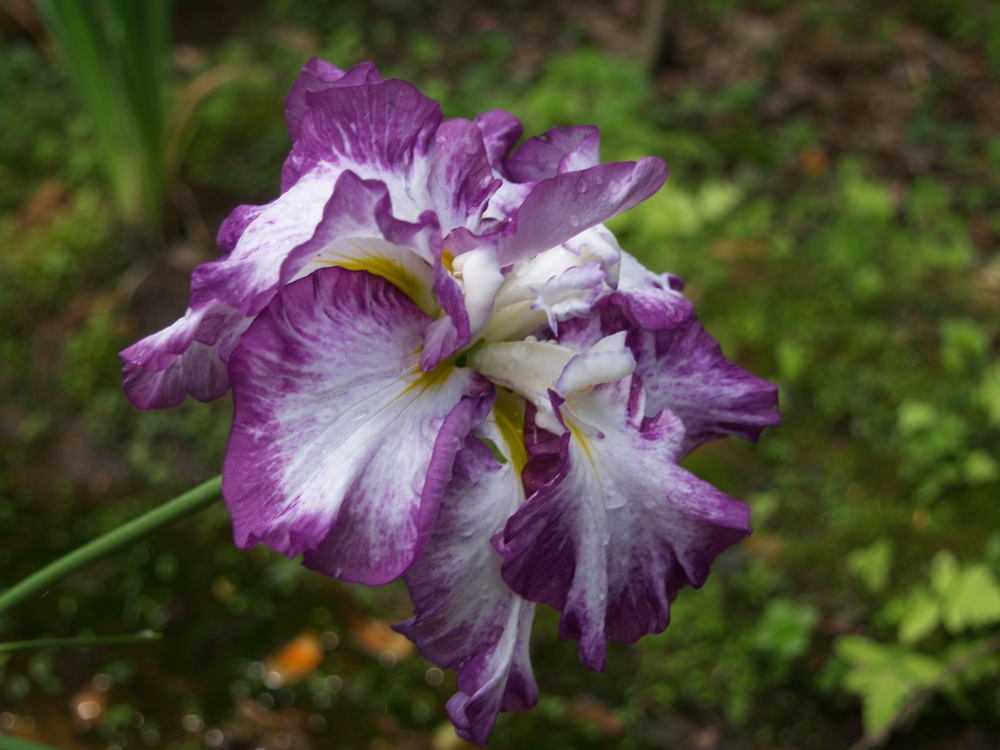I believe that irises have a reputation for being finicky, and I think that this is mostly with bearded irises that must be divided and watched for iris borers. I’ve concluded after years of trial and error (mostly error) that Japanese irises are the easiest and most beautiful of the the irises. I haven’t tried very hard, but I’ve fooled with Siberian, German, and Dutch irises off and on, with limited success. Well, less than limited since there are none left alive.
The rear garden is prone to sustained periods of overly damp soil through the spring, and any other season when there’s an inch or two of rainfall in a week. The splendid Siberian iris ‘Caesar’s Brother’ (Iris sibirica ‘Caesar’s Brother’, above in better days) is considered nearly bullet proof in wet or dry soils, but in my garden it died off after a few years. It was planted in good earth that alternated between flooded springs and bone dry summers, but I think that lack of sunlight eventually killed it.
My lust for planting flowering trees and Japanese maples has shaded much of the garden, so that I sometimes delude myself to consider any plant with sun at high noon to be in full sun. Some plants will tolerate the few hours of sunlight, but not irises. I’m guessing.
I’ve planted Louisiana (above) and yellow flag iris (Iris pseudoacorus, below) in shallow water in a few of the garden’s ponds with success. Louisiana iris is planted in containers in two ponds that are shaded through most of the day. Before trees grew to overhang the ponds this iris spread exuberantly so that excess growth required trimming a time or two each summer. But now, in more shade it stays put and still manages to bloom for most of a week.
Yellow flag iris is sturdy and aggressive enough to fill any area of shallow water. In my large swimming pond it’s planted in a large area of gravel that filters the pond’s water, and in gravel yellow flag spreads more slowly than it would in soil. It’s invasive if allowed into waterways, but I monitor the overflow of the pond to prevent its escape, and I’ve seen no sweet flag growing in the neighboring wetland.
I’ve planted a variety of Japanese irises (Iris ensata) between boulders in shallow water in the swimming pond, and a few in a damp, spring fed swale where other wetland plants are established. In soil, Japanese iris spreads moderately, but planted in full sun in small gravel and shallow water it preforms best, forming thick clumps.
Japanese iris blooms dependably, though each flower lasts for only a few days. On an established clump there will be dozens of flowers, and there will be ten days from first to last bloom. With several cultivars and slight variations in sunlight exposure, there will be flowering irises for a month.
No care is required, particularly when Japanese irises are planted in water. There are no bug or disease problems, and though I’ve heard that thick clumps benefit from dividing occasionally, I’ve left mine alone for nearly ten years with no apparent decline.
There is no magic to selecting the best varieties. I started with the variegated leaf type with dark purple flowers with a small streak of yellow (above). The foliage is attractive from mid spring through early autumn, but the flowers of many non-variegated types are larger and offer welcome variation in form and color.

Hi, Dave. Very nicely done information on irises. I am especially interested in the Louisiana iris you showed. I have never seen one with such narrow petal segments although some of the species do have that open form. It almost has the look of I. virginica or I. versicolor, I am only closely familiar with virginica but it and several other non-Louisiana native species will grow well in the conditions you describe. Virginica has a midrib in the leaves like pseudacorus, but Louisiana irises lack that feature. At any rate, if you have any more information on this particular plant, I would be interested in it. The forms of irises vary so widely within a species that they are often hard to distinguish.
– Patrick
Patrick, I planted this group of irises so long ago that I haven’t a clue which ones they are. Some days I can barely remember what I planted yesterday, but from fifteen or twenty years ago cultivar names are hard to come by. I wouldn’t bet the farm that they aren’t Iris veriscolor. I only recall planting some Louisiana irises at the time, but those could be long gone.